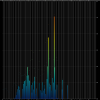One should be careful not to misunderstand Dr. Geddes. He considers THD as a single value (e.g. 1% THD@1kHz for an amplifier) or a THD curve to be rather meaningless, because there it is no longer apparent from which proportions of distortions with which order THD is composed.
However, the distortion diagrams
@amirm and
@hardisj present in their speaker reviews show the individual harmonic distortions according to their order from HD2 to HD5. Therefore, these measurements are quite useful.
Although no one can definitively say at what point exactly harmonic distortion is audible to the individual, it can be assumed that anything below the masking threshold is not audible (but one should always keep in mind that individual hearing thresholds can vary greatly).
As a very rough guideline, it can be said that for the same excitation, the higher the order of the harmonic distortions, the lower their masking and thus the more likely the distortions are to be audible.
Low tones are masked "better". The higher the sound pressure level, the better the masking - for more
details here.
The "worst" thing that can happen is high harmonic distortion in the 1-2kHz range, because masking is worst in this frequency range.
The worst masker of harmonic distortion is a single tone. Completely "pure" single tones are very rare when listening to music, but quite often almost pure tones occur, such as a piano keystroke.
This can then look like this, for example, that at C6 (~1kHz) there is an almost pure tone (overtones are of course always somewhat present) - more
details here.
View attachment 131923
A very good loudspeaker would now have so little harmonic distortion around 1kHz that it would always be below the perception threshold, i.e. completely masked by the 1kHz masker tone (the piano key stroke at 1kHz).
The masking diagram for a pure tone at 1kHz looks like this:
View attachment 131925
Source: Zwicker, Fastl - Psychoacoustics
So a 1kHz tone masker with 80dB SPL masks HD2 (a parasitic tone at 2kHz) up to about 43dB (or -37dB, see gray lines), but HD5 (a parasitic tone at 5kHz) only up to about 20dB (-60dB, see blue lines).
Similarly, the values for a 1kHz masker tone at 90dB SPL can be determined - HD2 53dB (-37dB) and HD5 43dB (-47dB).
View attachment 131928
Similarly, one can determine the perception thresholds for HD3.
This would result in the following theoretical perception thresholds for harmonic distortion at 80-90dB SPL for the frequency range around 1kHz:
HD2 (80/90dB): around -37dB
HD3 (80/90dB): -48dB / -41dB
HD5 (80/90dB): -60dB / -47dB
(Please do not interpret the dB values mentioned as absolute, +-1dB does not matter much, it is more about the qualitative conclusion)
So, to be absolutely sure that it is impossible to perceive harmonic distortion, a loudspeaker should be, preferably significantly, below these values.
Unfortunately, this is not the case in the example shown below. Both HD3 and HD5 are close to the range of theoretical perceptibility at 86dB (which, as mentioned, can vary from individual to individual) - so this could be better.
View attachment 131930
Even though it is not possible to clearly determine when harmonic distortions cause audible problems, it is fairly safe to say below which perception threshold no problems are very likely to be expected.


